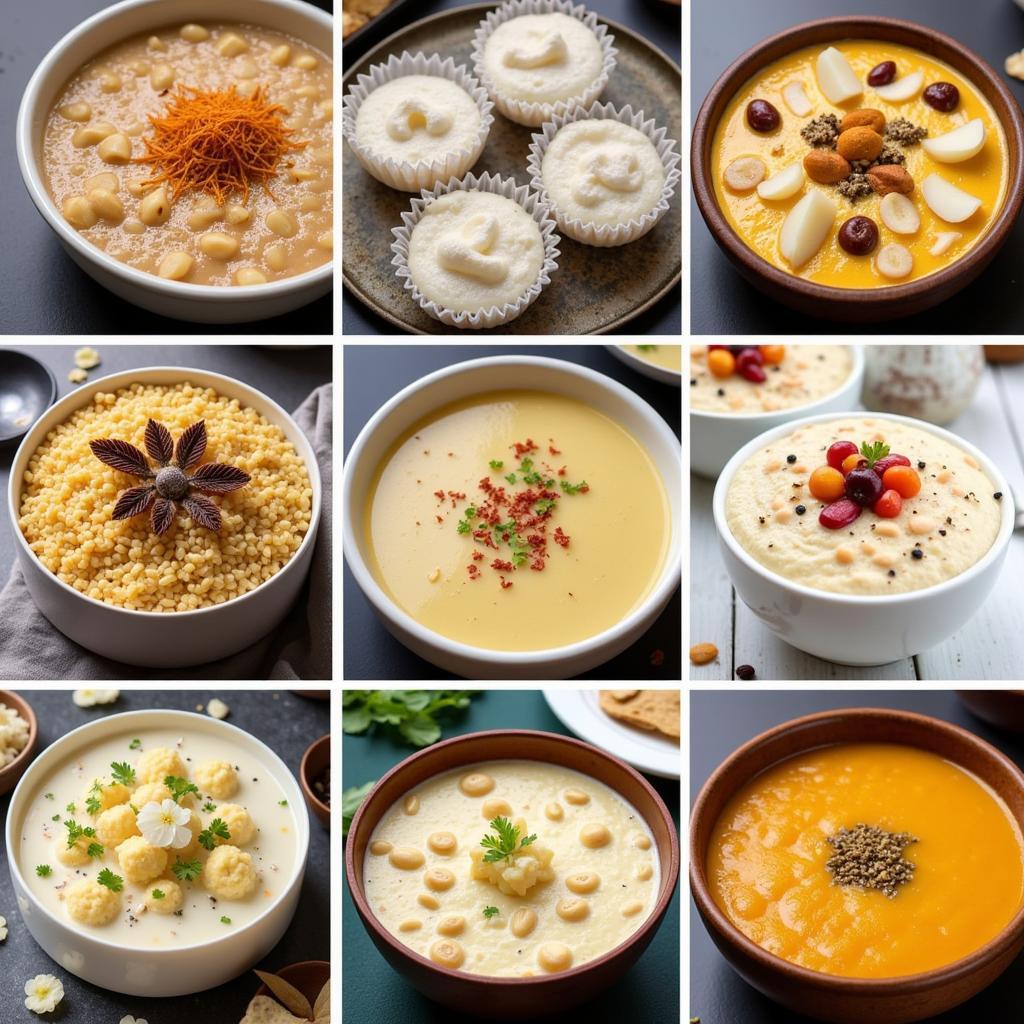Kheer, that creamy, sweet, and aromatic Indian dessert, is a beloved treat across the subcontinent. But what is kheer called in English? This article explores the various English translations for this delicious dish, diving into its cultural significance, regional variations, and the nuances of finding the perfect English equivalent.
Decoding “Kheer Ko English Mein Kya Kahate Hain”
The Hindi phrase “Kheer Ko English Mein Kya Kahate Hain” translates to “what is kheer called in English?” This simple question opens up a world of linguistic and culinary exploration. While a direct, single-word translation doesn’t perfectly capture the essence of kheer, several English terms come close. Understanding the context and the specific type of kheer being referred to helps in choosing the most appropriate translation.
Common English Translations for Kheer
- Rice Pudding: This is perhaps the most common and widely accepted translation for kheer. It accurately describes the core ingredients and texture of the dish, especially when made with rice.
- Indian Rice Pudding: This adds specificity, differentiating kheer from other global rice pudding variations.
- Milk Pudding: This is a broader term, encompassing various puddings made with milk, including kheer. It’s suitable when the specific grain used isn’t the primary focus.
- Sweet Rice Porridge: While “porridge” might not evoke the same creamy texture as kheer, it can be used, especially for thinner variations.
- Rice and Milk Dessert: This descriptive term is useful when explaining kheer to someone unfamiliar with Indian cuisine.
Regional Variations and Their English Names
Kheer takes on different forms across India, with variations in ingredients, cooking methods, and even names. These regional nuances can influence the most suitable English translation. For instance, payasam in South India, while similar to kheer, might be referred to as South Indian Rice Pudding or Vermicelli Pudding depending on the specific ingredients. Similarly, phirni, a thicker, denser version made with ground rice, could be termed Ground Rice Pudding.
Beyond Simple Translation: Capturing the Essence of Kheer
While the above translations provide a functional understanding of what kheer is, they often fail to capture its rich cultural significance and the emotions it evokes. Kheer is more than just a dessert; it’s a symbol of celebration, tradition, and comfort. It’s the sweet ending to a festive meal, a comforting dish during illness, and a cherished part of many religious ceremonies. Communicating this depth of meaning in English requires more than a simple translation; it requires storytelling and evocative descriptions.
 Regional Kheer Variations
Regional Kheer Variations
Why is Finding the Right English Translation Important?
Accurately translating kheer is crucial for several reasons. It allows for clear communication and understanding across cultures, facilitating the sharing of culinary traditions. It also aids in the accurate representation of Indian cuisine on global platforms, ensuring that kheer receives the recognition it deserves.
Kheer: A Culinary Delight Beyond Words
Ultimately, no single English word can fully encapsulate the essence of kheer. It’s an experience that transcends language, best understood through taste and shared cultural appreciation. While “rice pudding” might be the closest literal translation, embracing the nuances of its regional variations and its cultural significance allows for a deeper appreciation of this beloved Indian dessert.
Conclusion
So, what is kheer called in English? While “rice pudding” or “Indian rice pudding” are often used, the best translation depends on the context and the specific type of kheer. Understanding the cultural significance and regional variations of this delicious dessert allows for a richer appreciation of its unique place in Indian cuisine. Remember, experiencing kheer firsthand is the best way to truly understand its magic. kheer remains a symbol of celebration and comfort, regardless of what language it’s described in.
FAQs
-
Is kheer the same as rice pudding? While similar, kheer often incorporates aromatic spices like cardamom and saffron, giving it a distinct flavor profile.
-
What are some common variations of kheer? Variations include phirni (made with ground rice), payasam (a South Indian version), and kheer made with different grains like semolina or vermicelli.
-
Can kheer be served hot or cold? Kheer can be enjoyed both warm and chilled.
-
What are some common garnishes for kheer? Chopped nuts, dried fruits, and a sprinkle of cardamom powder are popular garnishes.
-
Is kheer difficult to make? Kheer is surprisingly easy to make, requiring just a few basic ingredients and simple cooking techniques.
-
What is the shelf life of kheer? Refrigerated kheer typically lasts for 2-3 days.
-
Is kheer a healthy dessert? While kheer is a treat, it can be part of a balanced diet when consumed in moderation.
Situations where you might ask “kheer ko english mein kya kahate hain”:
- Ordering at an Indian restaurant in an English-speaking country.
- Explaining kheer to a non-Indian friend.
- Searching for kheer recipes online in English.
- Writing about kheer in an English publication.
Explore more about Indian desserts on ViperCircle:
- Gulab Jamun: The King of Indian Sweets
- Jalebi: The Crispy, Syrupy Delight
- Rasgulla: The Spongy Sweet Treat
For any assistance, please contact us at Contact@ViperCircle.com or visit our office at G-5, लोअर परेल, सेनापति बापट मार्ग, मुंबई, महाराष्ट्र – 400013, भारत।. We have a 24/7 customer support team.